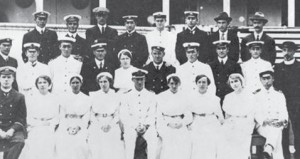 As we completed the final touches on the September 2014 Journal, I was fortunate to receive an e-mail from Michael Dowsett, one of the former Directors General Naval Health Service, who reminded that it was the 100th Anniversary of an important Navy health event from the beginning on the First World War. A short summary is below:
As we completed the final touches on the September 2014 Journal, I was fortunate to receive an e-mail from Michael Dowsett, one of the former Directors General Naval Health Service, who reminded that it was the 100th Anniversary of an important Navy health event from the beginning on the First World War. A short summary is below:
‘A hundred years ago, on the 30th August 1914, the Royal Australian Navy Hospital Ship GRANTALA departed Sydney. She had been quickly converted from the peacetime Adelaide Steamship coastal passenger ship to her role as a hospital ship with the inclusion of an operating theatre that had been specially built at Garden Island. In place of dining and music saloons, there were medical, surgical, observation and infectious disease wards. Without overcrowding, she could carry 250-300 patients; all fitted with Navy pattern cots that could swing with the motion of the ship.
 She sailed with a complement of 8 medical officers, 7 nursing sisters and about 30 sick berth stewards. Sister Kirkcaldie recorded their departure:
She sailed with a complement of 8 medical officers, 7 nursing sisters and about 30 sick berth stewards. Sister Kirkcaldie recorded their departure:
“We passed down the harbour to the accompaniment of cheers and farewells from land and water and while we laughed at the excitement we created, our throats tightened as we thought of the dear ones we were leaving behind…as we entered the Heads a rousing cheer greeted us from the men already on duty at South Head. The fl at the fort dipped in salute.”
“Our little ship – for all its brave array – boasted only of some 3000 tons and as we cleared the Heads we ran into rough seas. Half an hour before we left Sydney we had been told that our first port of call would be Townsville.”
GRANTALA had been converted into a hospital ship to provide medical support for the Australian Fleet, particularly if there was to be a confrontation between The Fleet and the German Pacific squadron, which was believed to be in the vicinity of Rabaul. Her first task was the support of the landings in Rabaul that captured German New Guinea.’
In this issue, we are have a range of articles that highlight the complex nature of military health, including original articles on anaemia, alcohol consumption, physical training and a glimpse of future battlefield medicine; review articles on sexually transmitted illnesses, and post-traumatic stress, and an excellent promyelocytic leukaemia case study. We continue to get a good range of articles, but other military and veterans’ health articles are always very welcome and we would encourage all our readers to consider writing on their areas of military or veterans’ health interest.
Dr Andy Robertson, CSC, PSM Captain, RANR
Editor-in-Chief






